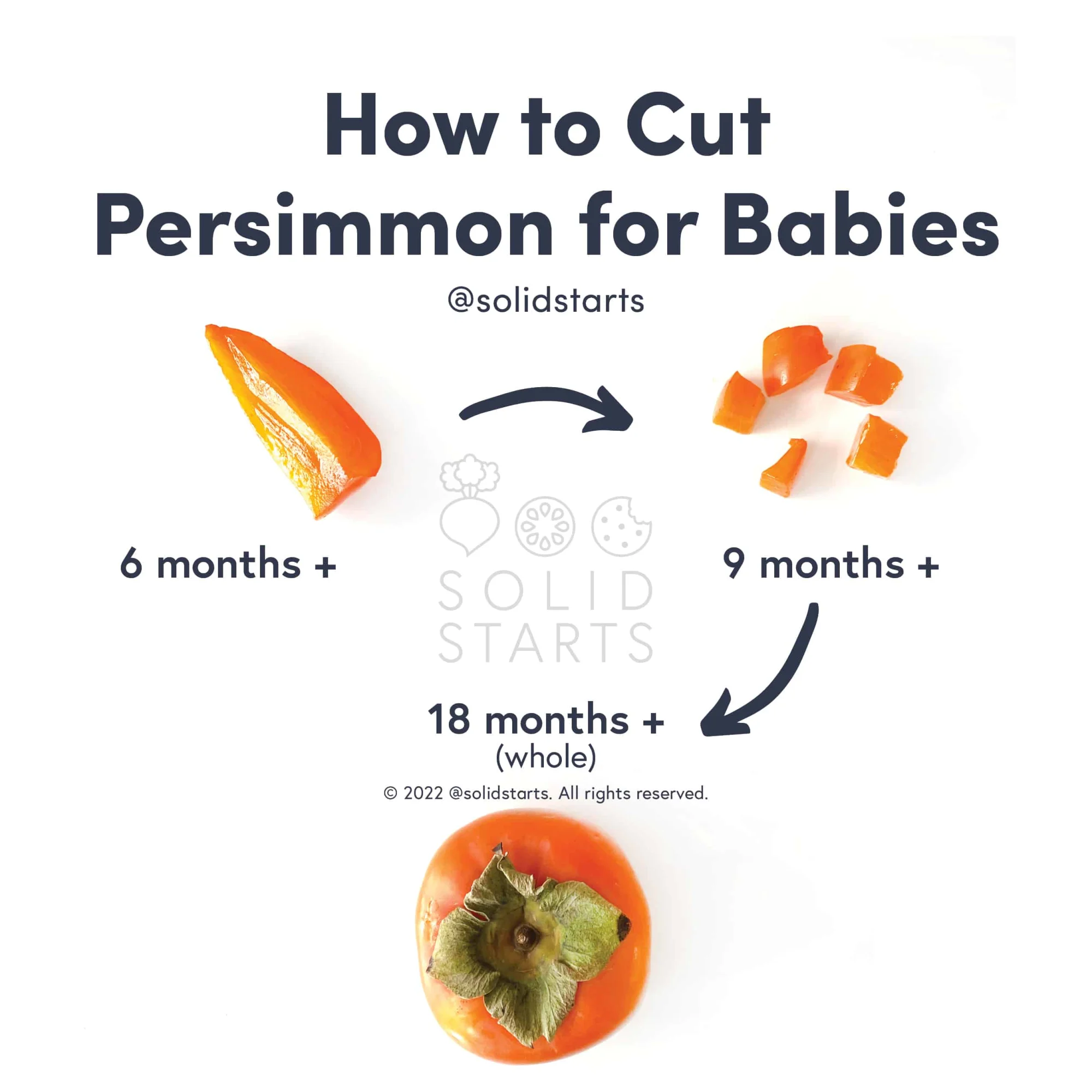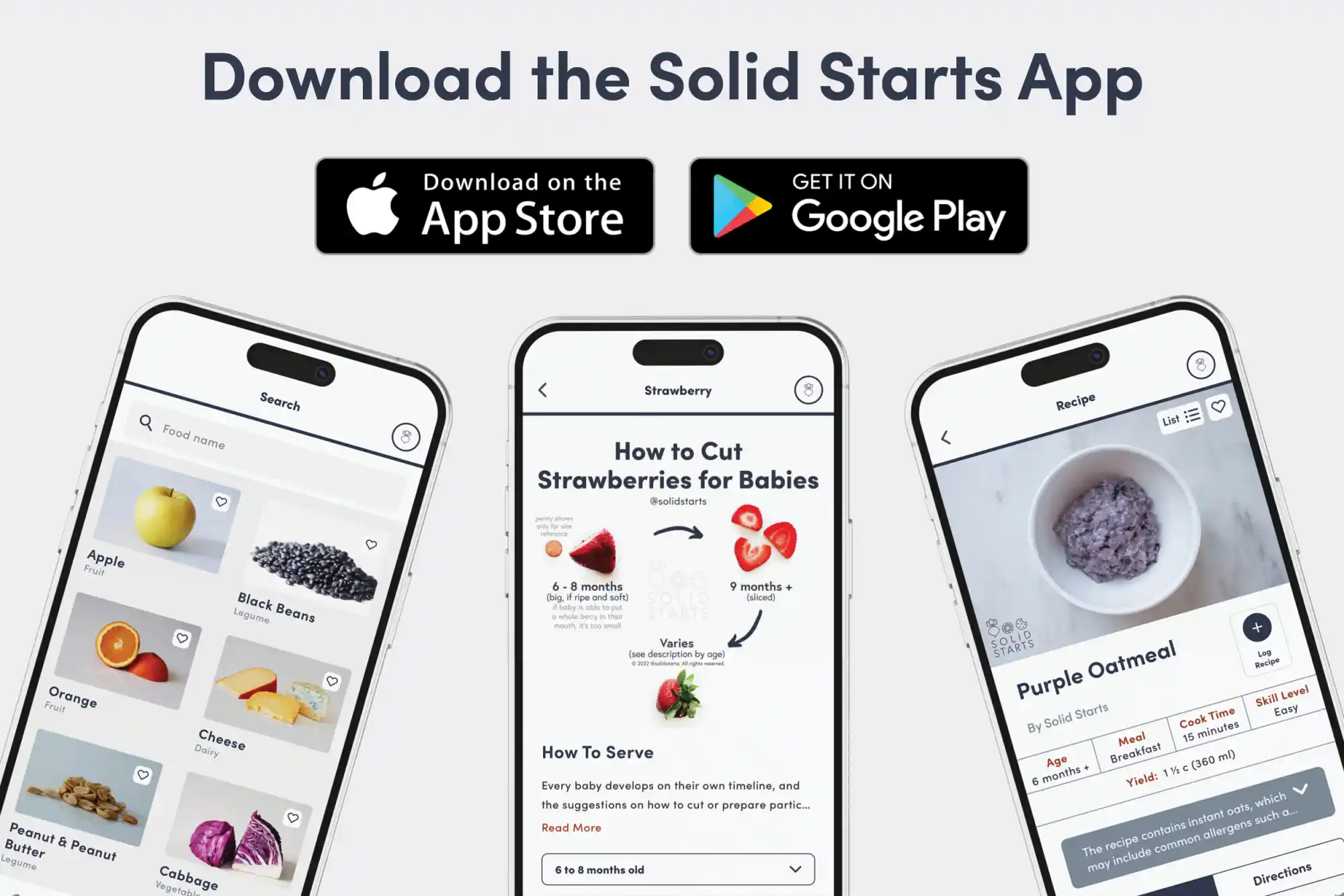Access our First Foods® Database in the Solid Starts App.
Learn morePersimmon
Fruit
Age Suggestion
6 months
Iron-Rich
No
Common Allergen
No

When can babies have persimmon?
Persimmon may be introduced as soon as baby is ready to start solids, which is generally around 6 months of age. Note: Unripe persimmon can cause a dry, numbing sensation in the mouth that is harmless but surprising to those who are experiencing the fruit for the first time.
Persimmons are the large berries that grow on deciduous trees in the world’s temperate and subtropical regions. There are different varieties – some round, others shaped like a heart – and each ranges in color from deep red to fiery orange to sunny yellow. Two of the most widely grown varieties, Fuyu and Hachiya persimmons, originated in Asia, where they are known as gam, kaki, khormaloo, japani phal, and shi, among other names. The fruit’s name in English has roots in the Cree language of North America, where the native variety of persimmon has long been prized as a source of food, medicine, and wood.
How do you serve persimmons to babies?
Every baby develops on their own timeline, and the suggestions on how to cut or prepare particular foods are generalizations for a broad audience.
6 months old +:
If the persimmon is heart-shaped (Hachiya persimmon), wait until the fruit is very ripe and mushy to the touch. Cut the fruit in half and scoop out the flesh from the skin. Serve in a bowl for baby to self-feed, either with their hands or a pre-loaded spoon. For firmer varieties, such as Fuyu, let the fruit over-ripen until it’s very soft and mashes readily when gently pressed and offer baby a large wedge of persimmon with any seeds removed. Alternatively, you can cook persimmon halves until soft and easily pierceable with a fork, then serve as a finger food or mash the fruit to make a sauce that can be stirred into soft, scoopable foods.
9 months old +:
If working with Hachiya persimmon (heart-shaped), wait until the fruit is ripe and custardy. Cut the persimmon in half and allow the child to practice scooping with a spoon. If you have a firm variety of persimmon such as Fuyu, ripen the fruit at room temperature until it feels tender like a ripe pear, peel the skin if desired, halve, and deseed the fruit if needed. From there you can offer bite-sized pieces, quarters, thin rounds, halves, or even the whole fruit, with or without the skin. Babies often chew on the skin and spit it out, and while this may seem like waste, building familiarity with skin can help encourage a child to eat fruit with the skin later in life. Plus, the act of chewing and spitting the skin helps develop oral-motor and grinding skills.
18 months old +:
When the soft, heart-shaped, custardy variety of persimmon (Hachiya) is fully ripe and you feel comfortable with the toddler’s eating skills, you may offer the whole persimmon. Just remain close by and coach the child how to spit out any bothersome pieces of skin or small seeds. If you have a firm variety such as Fuyu, this is a great time to serve quarter pieces, thin round slices, or a whole persimmon. If the child is struggling with the skin, simply peel the persimmon, or peel it in “stripes” so that some skin is left on for exposure.


If you are stuck in a puffs and pouches rut, check out our guide, 100 Snacks for Babies & Toddlers for healthy and easy ideas.
Videos
Are persimmons a choking hazard for babies?
Yes. While some varieties of ripe persimmon can be soft and mashable, others can be firm and slippery, even when ripe, and these are qualities that can increase the risk of choking. To reduce the risk, make sure that the persimmon is very soft, and prepare and serve persimmons in an age-appropriate way as described in the How to Serve section. As always, make sure you create a safe eating environment and stay within an arm’s reach of baby during meals.
Learn the signs of choking and gagging and more about choking first aid in our free guides, Infant Rescue and Toddler Rescue.
Are persimmons a common allergen?
No. Persimmon allergies are rare, though they have been reported. Individuals with allergies to birch pollen, sensitivity to latex, or Oral Allergy Syndrome (also called pollen food allergy syndrome) may be sensitive to persimmon. Oral Allergy Syndrome typically results in short-lived itching, tingling, or burning in the mouth and is unlikely to result in a dangerous reaction. Peeling and cooking the fruit can help minimize or even eliminate the oral allergy reaction.
As you would when introducing any new food, start by offering a small amount on its own for the first few servings. If there is no adverse reaction, gradually increase the amount served over future meals.
Are persimmons healthy for babies?
Yes. Persimmons offer carbohydrates, fiber, and fluid, in addition to potassium and vitamins A, B6, C, E, and K. Together, these nutrients help provide energy to support baby’s movement and exploration, gut microbiome, and hydration. They also help to support electrolyte balance, vision, metabolic processes, skin health, iron absorption, immune function, and blood clotting. Lastly, the fruit contains the antioxidants lutein and zeaxanthin, which support strong vision and overall health in the body.
Do persimmons cause digestive problems?
No, not when offered as part of a varied diet.
For individuals with pre-existing digestive problems, eating large quantities of fiber-rich foods like persimmons frequently may cause constipation or, even more rarely, a bezoar (an indigestible mass that creates a blockage in the digestive tract). In general, food-related bezoars are extremely rare and are uncommon in children. Rest assured that persimmons are an excellent food to serve to babies and toddlers as long as the fruit is prepared in a developmentally-appropriate way and offered as part of a varied diet.
Can babies have dried persimmon?
No. Dried persimmon (also known as gotham, hong kho, hoshigaki, etc.) can be firm and challenging to chew, qualities that increase the risk of choking. If a recipe or dish you’d like to share with baby calls for dried persimmon, try rehydrating the fruit in warm water until fully softened, finely chop, and mix it into the dish.
Our Team
Written by
Expert Tips Delivered to Your Inbox
Sign up for weekly tips, recipes and more!







